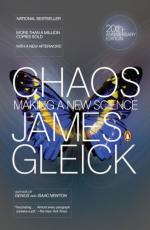
|
| Name: _________________________ | Period: ___________________ |
This test consists of 5 multiple choice questions, 5 short answer questions, and 10 short essay questions.
Multiple Choice Questions
1. In his paper, Kuhn argues that rival paradigms are ______, meaning that it is not possible to understand one paradigm through the conceptual framework and terminology of another rival paradigm.
(a) Incomprehensible.
(b) Incommensurable.
(c) Indistinguishable.
(d) Incorrigible.
2. In Chapter 2, "Revolution," Gleick writes that the only problem with studying and experimenting with a new science is what?
(a) No one will understand it.
(b) It requires a new language.
(c) All the work is yet to be done.
(d) There are no rules.
3. From what institution did Thomas S. Kuhn earn his B.S., M.S. and Ph.D. degrees in physics?
(a) Loyola University.
(b) Harvard University.
(c) Princeton University.
(d) Stanford University.
4. In Chapter 1, "The Butterfly Effect," the author writes, "The Butterfly Effect acquired a technical name: sensitive dependence on _____________"?
(a) "Random conditions."
(b) "Initial conditions."
(c) "Ideal conditions."
(d) "Controlled conditions."
5. What is a natural science that involves the study of matter and its motion through spacetime, along with related concepts such as energy and force?
(a) Physiology.
(b) Thermodynamics.
(c) Fluid dynamics.
(d) Physics.
Short Answer Questions
1. When was Benoit Mandelbrot born?
2. In what year did Edward Lorenz create a weather simulator as described in Chapter 1, "The Butterfly Effect"?
3. Who is attributed with the following quote in the beginning of Chapter 3, "Life's Ups and Downs": "The result of a mathematical development should be continuously checked against one's own intuition about what constitutes reasonable biological behavior"?
4. Robert May, like many before him, was confused by the changes when what was increased?
5. Where was Hendrik Houthakker born?
Short Essay Questions
1. What did Edward Lorenz develop in order to assist in working with computer technology in Chapter 1, "The Butterfly Effect"? How did he feel about the future of forecasting?
2. What psychological experiment does Thomas S. Kuhn describe in Chapter 2, "Revolution"?
3. How is James Yorke described in Chapter 3, "Life's Ups and Downs"? What term did he coin?
4. How is a Cantor set described in Chapter 4, "A Geometry of Nature"?
5. In Chapter 3, "Life's Ups and Downs," one of the biggest questions came to be how different parameters affected the ultimate destiny of a changing population. What was the answer to this?
6. Describe the weather simulator discussed in Chapter 1, "The Butterfly Effect." What weather conditions did it create?
7. What variable changed the outcome in the experiment described by Thomas S. Kuhn in Chapter 2, "Revolution"?
8. What impact did The Structure of Scientific Revolutions have on the scientific community? What did Kuhn assert in the book?
9. How did Lorenz develop ways to reproduce complex behavior in Chapter 1, "The Butterfly Effect"?
10. In Chapter 2, "Revolution" Gleick refers to the pendulum as being the laboratory mouse of chaos, the new science. What metaphorical examples does Gleick give for other great scientists in this chapter?
|
This section contains 977 words (approx. 4 pages at 300 words per page) |

|




